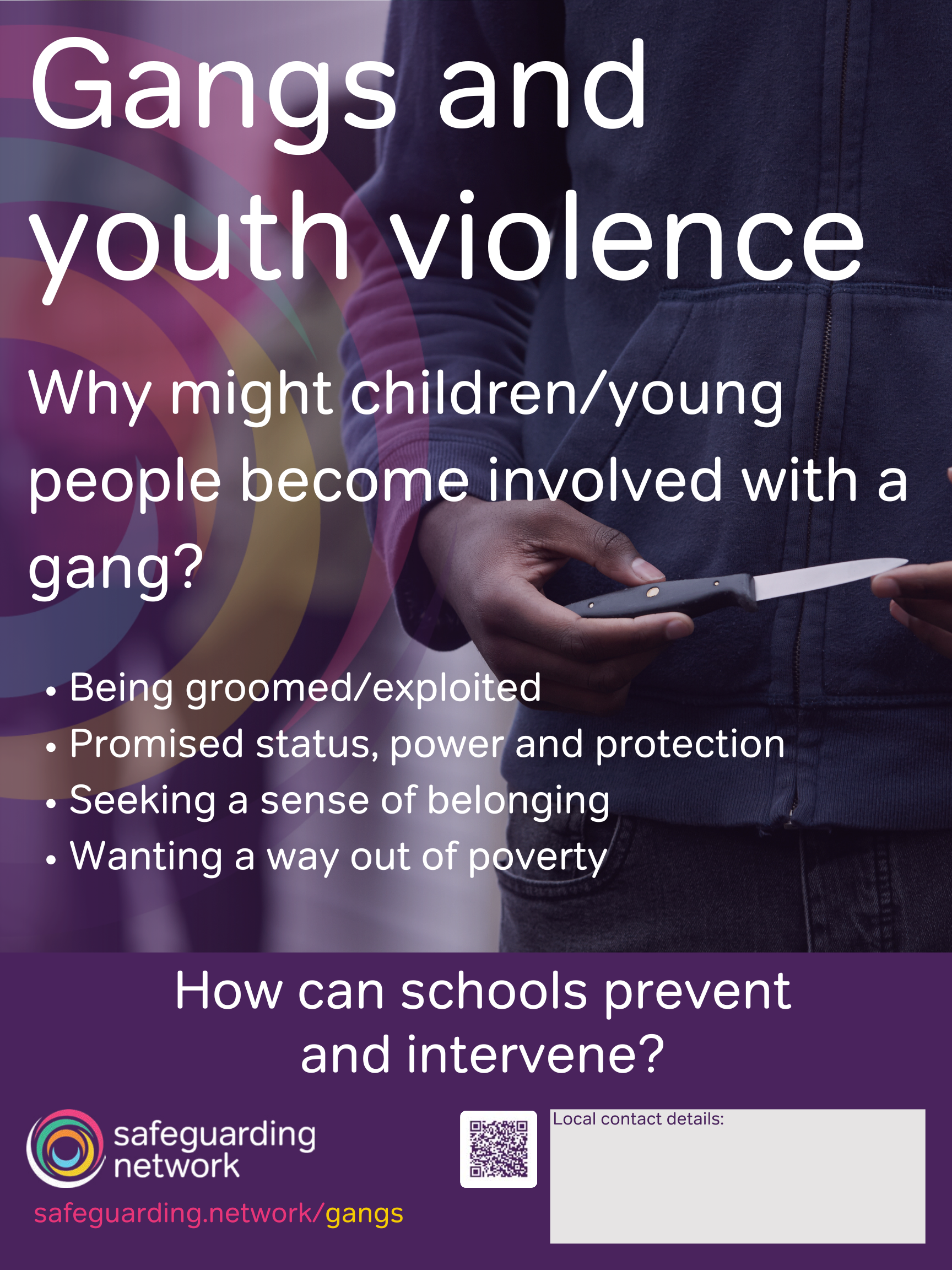Introduction
Gang membership and associated youth violence can have a devastating impact on children, young people and their families.
Being part of a peer group is seen as a normal part of childhood development. However, peer groups are less defined and organised than gangs, and membership of peer groups is fairly fluid, i.e., members can come and go as they please.
It’s also relatively normal for groups of children to get together in public places because this allows them to share news, ideas, etc., and potentially do things that they would not be able to get away with whilst under the watchful eyes of adults. For some, this may involve low-level criminality, however, this does not necessarily make them a gang – gangs have clear structures and tasks.
Need more?
Thank you for visiting our resources pages. These are free to everyone as is our fortnightly safeguarding bulletin – general safeguarding information is too important to restrict. Become a member to access lots more, including training materials for you to deliver in-house on each topic in Keeping Children Safe in Education.
Sign up for FREE fortnightly bulletin.
What about training?
We can deliver training for your setting on this and other subjects via online platforms, or face-to-face in certain areas. Just get in touch to discuss your requirements.
Definition of a gang
A gang is a relatively durable, predominantly street-based group of young people who see themselves (and are seen by others) as a discernible group and engage in a range of criminal activity and violence. They may also identify with or lay claim over territory, have some form of identifying structure feature, and/or are in conflict with other, similar gangs.
Adapted from Serious youth violence: County lines drug dealing and the Government response, 2022
In 2023, 11,110 children assessed by children’s social care were deemed to be at risk due to gang involvement, and this is likely only the tip of the iceberg as many gangs are still unknown to the authorities.
Youth violence
Youth violence is often synonymous with gangs.
In its report, Children, violence and vulnerability, the Youth Endowment Fund found:
- 47% of teens had been a victim or witness of violence in the last 12 months.
- 68% of child victims said they’d experienced violence that led to physical injuries.
- 60% of children saw real-world acts of violence on social media and 29% had seen content relating to weapons.
- 47% of children reported that violence and the fear of violence impacted their day-to-day lives.
Knife crime and county lines
Over recent years, there has been continuing concern about knife crime.
Recent data from the Office for National Statistics (ONS) shows that there were 282 killings involving knives in the 12 months to March 2022— nearly a 20% increase from the previous year. The same data shows that 51 of those killed by knives were 13 to 19 years of age and that the number of male victims aged 16 and 17 increased from 10 to 24.
Youth violence is also linked to county lines. Children are increasingly being targeted and recruited online by county lines gangs using social media. Children can easily become trapped by this type of exploitation as county lines gangs can manufacture drug debts which need to be worked off, and/or threaten serious violence towards and/or kidnap victims (or members of their families) if they attempt to leave the county lines network.
Additional vulnerabilities
Any child or young person may become involved in gangs and youth violence. However, certain groups may be more vulnerable, including those experiencing:
- a chaotic home life where children are not a priority;
- poor supervision from an early age;
- issues within the home (e.g., domestic abuse, mental ill-health);
- a familial history of offending;
- additional needs;
- poor engagement with education or have been permanently excluded from school;
- poor self-image/self-esteem;
- being in care.
Reasons for joining a gang
Children and young people may join a gang for several reasons, including:
- the need for a sense of belonging and purpose;
- to gain respect, status or power;
- for protection;
- being recruited by other gang members;
- being pressured to join;
- boredom;
- poverty;
- feeling they will not find a better life or good job;
- financial gain (legal or otherwise).
Spot the signs
Possible indicators include:
- aggression and/or non-compliance;
- difficulty concentrating;
- difficulty developing relationships;
- reduction in attendance and/or attainment, going missing;
- poor self-esteem, depression or anxiety;
- self-harm;
- substance misuse;
- changes in behaviour and appearance;
- unexplained possessions;
- refusal to enter certain areas;
- a new nickname or starts to use tags/graffiti on books/possessions.
What to do
- Create an environment based on equality and informed choice – provide information to allow pupils to make informed choices. It’s well established that success in learning is one of the most powerful factors in the prevention of youth crime.
- Check young people have safe relationships – in their family, with their peers and with your staff. Create an environment where it’s okay to talk even about the most difficult things.
- Contextual approach – be aware of the risks to children and young people in your local area concerning gangs and youth violence.
- Multi-agency working – collaborate with the police, local government, youth offending teams, and health and probation services, to share data and information. Jointly create plans to prevent and reduce serious violence within local communities.
- Know the signs and know what to do – use the checklists above, your safeguarding procedures and be confident in raising gang and youth violence as a possibility.
- Take action – and keep taking action until you know children and young people are safe.
Free gangs and youth violence poster
This free, downloadable resource raises the profile of safeguarding for your staff team. For use in staff rooms, on safeguarding boards or on the back of toilet doors, the poster includes tips, a space for local contact details, plus a link and QR codes to this resource page. Find it in the resources section below.
DSL Training Materials
-

Gangs and Youth Violence Presentation
-

Gangs and Youth Violence - Presenter Notes
-

Handout for staff - Gangs and Youth Violence
-

Gangs and Youth Violence Quiz
-

Gangs and Youth Violence – Quiz (Answer Sheet)
-

Gangs and Youth Violence scenario – EYFS Settings
-

Gangs and Youth Violence scenario (EYFS settings) – DSL Information sheet
-

Gangs and Youth Violence scenario – Primary school
-

Gangs and Youth Violence scenario (primary) – DSL Information sheet
-

Gangs and Youth Violence scenario – Secondary Schools
-

Gangs and Youth Violence scenario (secondary) – DSL Information sheet
-

Gangs and Youth Violence scenario – 16+ Settings
-

Gangs and Youth Violence scenario (16+ settings) – DSL Information sheet
-

Gangs and Youth Violence scenario – SEND focus
-

Gangs and Youth Violence scenario (SEND focus) – DSL Information sheet
-

Gangs and Youth Violence scenario – Care Settings
-

Gangs and Youth Violence scenario (care settings) – DSL Information sheet
Resources
-

Gangs and youth violence poster
-

Children, Violence and Vulnerability 2023
-

How to access support from a SAFE Taskforce
-

Power The Fight: Therapeutic Intervention for Peace (TIP) Report
-

Preventing and reducing serious violence: Draft Guidance for responsible authorities
-

Fearless
-

Anti-social media
-

Fearless Resources
Save time and improve your safeguarding approach…
Bite-size training materials to share with your staff every month.
Support to explore and develop your safeguarding culture.
A huge array of resources and professional experience at your fingertips.
Get in touch now for a personal tour of the site and details of membership benefits.
We look forward to working with you.


